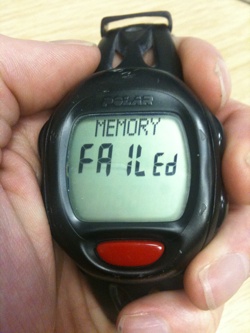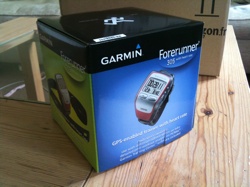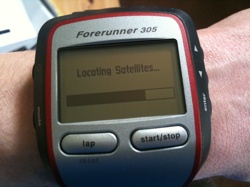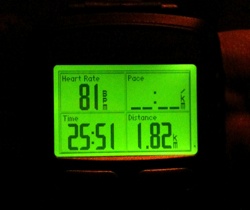
Like me, my Polar heart rate monitor, chronometer, speedometer and sole training partner (other than my shadow, but he hasn’t been out much lately) has been struggling recently. His memory failed this week after getting a little water inside his case, and he’s never really recovered. Sorry buddy, but it’s time for a replacement.
 Polar have gone weird since I bought this S625x many years ago. Their cheaper models are crippled so that you can’t get all your data off (but instead are only given the amount of time you spent in certain heart rate zones – useless for reviewing intervals and tempo work) and their expensive models are super expensive (and no longer competitive). They seem to have dumped their software development and keep hinting at new technologies using new standards (i.e. their stuff will only work with their stuff). Sod that, I thought. The move to Garmin gives a device with Mac software so I don’t have to keep rebooting into XP just to get my data every day, clever online software so I can upload from different machines and still get the original data out to use elsewhere, ANT+ connectivity so I can use devices from a bunch of other manufacturers, and built in GPS. Their accessories are sensibly priced too.
Polar have gone weird since I bought this S625x many years ago. Their cheaper models are crippled so that you can’t get all your data off (but instead are only given the amount of time you spent in certain heart rate zones – useless for reviewing intervals and tempo work) and their expensive models are super expensive (and no longer competitive). They seem to have dumped their software development and keep hinting at new technologies using new standards (i.e. their stuff will only work with their stuff). Sod that, I thought. The move to Garmin gives a device with Mac software so I don’t have to keep rebooting into XP just to get my data every day, clever online software so I can upload from different machines and still get the original data out to use elsewhere, ANT+ connectivity so I can use devices from a bunch of other manufacturers, and built in GPS. Their accessories are sensibly priced too.
 The Forerunner 305 has also been around for some years now, but people have been very, very happy with their 305’s and the price is awesome for the features (around £135 on Amazon). OK, this thing is a massive chunk of plastic on my wrist, which I wasn’t too impressed with. I would have gone with the smaller 405 but I’m a little lean in the wallet after Christmas, kids’ birthdays, the exhaust falling off, tax returns, etc. Really, as a wannabe triathlete, I should have bought the Garmin 310XT – it’s the only device like this in their range that is waterproof. You can’t swim with the 305. The 310XT has a bunch of extra features that makes its price of twice that of the 305 worthwhile. I’m not going to be racing with this chunk on my arm though, so I decided I’d take the cheap option. I don’t want all this data when I’m racing but I do want it for training (as much for studying after as for during). I’ll try to pick up something cheaper and smaller for racing (time, laps, HR and waterproofing will do me).
The Forerunner 305 has also been around for some years now, but people have been very, very happy with their 305’s and the price is awesome for the features (around £135 on Amazon). OK, this thing is a massive chunk of plastic on my wrist, which I wasn’t too impressed with. I would have gone with the smaller 405 but I’m a little lean in the wallet after Christmas, kids’ birthdays, the exhaust falling off, tax returns, etc. Really, as a wannabe triathlete, I should have bought the Garmin 310XT – it’s the only device like this in their range that is waterproof. You can’t swim with the 305. The 310XT has a bunch of extra features that makes its price of twice that of the 305 worthwhile. I’m not going to be racing with this chunk on my arm though, so I decided I’d take the cheap option. I don’t want all this data when I’m racing but I do want it for training (as much for studying after as for during). I’ll try to pick up something cheaper and smaller for racing (time, laps, HR and waterproofing will do me).
So this thing is a chunk of tech. It’s not ugly, but it ain’t pretty. It’s light enough so that you don’t really notice it when running. Just like the iBike though, when you start using it and you see the huge range of data collected, stored and displayed you see the thing’s worth. Using GPS and tracking your route  instills a feeling of flexibility (maybe I’ll nip down that path & I don’t have to remember the route later, it’s all going to be collected) and confidence in its accuracy. If it can see a bunch of satellites and show you which side of the road you ran on it has got to be pretty damned accurate for pace and distance. Running with a footpod (an accelerometer that calculates pace and distance from the movements of your foot) is fairly accurate once you’ve calibrated it, as long as you run in the same shoes and don’t change surfaces too much. It puts you off exploring off-road trails if you want to collect your data somewhat obsessively like me. Running tempos or intervals downhill gave bizarre speed readings with the footpod, but I expect the GPS to be more useful here. We’ll see.
instills a feeling of flexibility (maybe I’ll nip down that path & I don’t have to remember the route later, it’s all going to be collected) and confidence in its accuracy. If it can see a bunch of satellites and show you which side of the road you ran on it has got to be pretty damned accurate for pace and distance. Running with a footpod (an accelerometer that calculates pace and distance from the movements of your foot) is fairly accurate once you’ve calibrated it, as long as you run in the same shoes and don’t change surfaces too much. It puts you off exploring off-road trails if you want to collect your data somewhat obsessively like me. Running tempos or intervals downhill gave bizarre speed readings with the footpod, but I expect the GPS to be more useful here. We’ll see.
This morning’s complicated run gave it a good test, although on snow and ice I could only guess that the pacing was about right from experience. The next few months should give it a strong test though. It’s already feeling good to be able to access my data on my computer and not be forced to reboot into Windows.